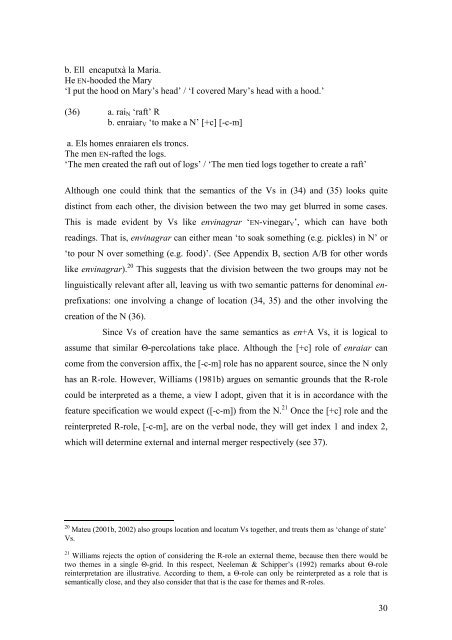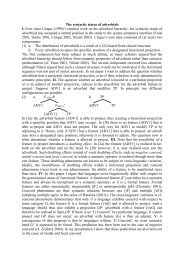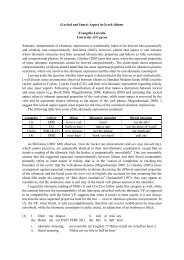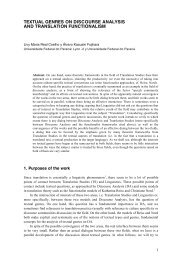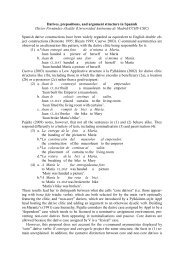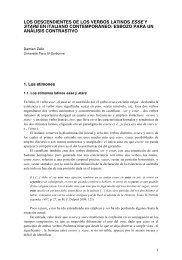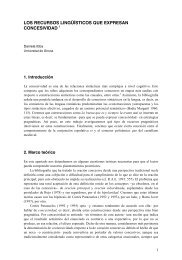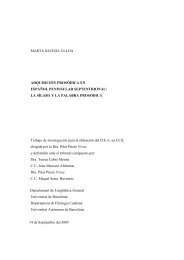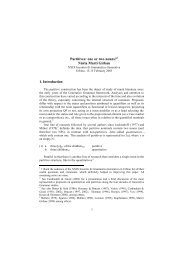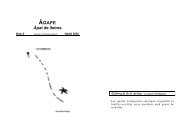Prefixation in English and Catalan - Departament de Filologia ...
Prefixation in English and Catalan - Departament de Filologia ...
Prefixation in English and Catalan - Departament de Filologia ...
You also want an ePaper? Increase the reach of your titles
YUMPU automatically turns print PDFs into web optimized ePapers that Google loves.
. Ell encaputxà la Maria.<br />
He EN-hoo<strong>de</strong>d the Mary<br />
‘I put the hood on Mary’s head’ / ‘I covered Mary’s head with a hood.’<br />
(36) a. raiN ‘raft’ R<br />
b. enraiarV ‘to make a N’ [+c] [-c-m]<br />
a. Els homes enraiaren els troncs.<br />
The men EN-rafted the logs.<br />
‘The men created the raft out of logs’ / ‘The men tied logs together to create a raft’<br />
Although one could th<strong>in</strong>k that the semantics of the Vs <strong>in</strong> (34) <strong>and</strong> (35) looks quite<br />
dist<strong>in</strong>ct from each other, the division between the two may get blurred <strong>in</strong> some cases.<br />
This is ma<strong>de</strong> evi<strong>de</strong>nt by Vs like env<strong>in</strong>agrar ‘EN-v<strong>in</strong>egarV’, which can have both<br />
read<strong>in</strong>gs. That is, env<strong>in</strong>agrar can either mean ‘to soak someth<strong>in</strong>g (e.g. pickles) <strong>in</strong> N’ or<br />
‘to pour N over someth<strong>in</strong>g (e.g. food)’. (See Appendix B, section A/B for other words<br />
like env<strong>in</strong>agrar). 20 This suggests that the division between the two groups may not be<br />
l<strong>in</strong>guistically relevant after all, leav<strong>in</strong>g us with two semantic patterns for <strong>de</strong>nom<strong>in</strong>al enprefixations:<br />
one <strong>in</strong>volv<strong>in</strong>g a change of location (34, 35) <strong>and</strong> the other <strong>in</strong>volv<strong>in</strong>g the<br />
creation of the N (36).<br />
S<strong>in</strong>ce Vs of creation have the same semantics as en+A Vs, it is logical to<br />
assume that similar Θ-percolations take place. Although the [+c] role of enraiar can<br />
come from the conversion affix, the [-c-m] role has no apparent source, s<strong>in</strong>ce the N only<br />
has an R-role. However, Williams (1981b) argues on semantic grounds that the R-role<br />
could be <strong>in</strong>terpreted as a theme, a view I adopt, given that it is <strong>in</strong> accordance with the<br />
feature specification we would expect ([-c-m]) from the N. 21 Once the [+c] role <strong>and</strong> the<br />
re<strong>in</strong>terpreted R-role, [-c-m], are on the verbal no<strong>de</strong>, they will get <strong>in</strong><strong>de</strong>x 1 <strong>and</strong> <strong>in</strong><strong>de</strong>x 2,<br />
which will <strong>de</strong>term<strong>in</strong>e external <strong>and</strong> <strong>in</strong>ternal merger respectively (see 37).<br />
20<br />
Mateu (2001b, 2002) also groups location <strong>and</strong> locatum Vs together, <strong>and</strong> treats them as ‘change of state’<br />
Vs.<br />
21 Williams rejects the option of consi<strong>de</strong>r<strong>in</strong>g the R-role an external theme, because then there would be<br />
two themes <strong>in</strong> a s<strong>in</strong>gle Θ-grid. In this respect, Neeleman & Schipper’s (1992) remarks about Θ-role<br />
re<strong>in</strong>terpretation are illustrative. Accord<strong>in</strong>g to them, a Θ-role can only be re<strong>in</strong>terpreted as a role that is<br />
semantically close, <strong>and</strong> they also consi<strong>de</strong>r that that is the case for themes <strong>and</strong> R-roles.<br />
30


